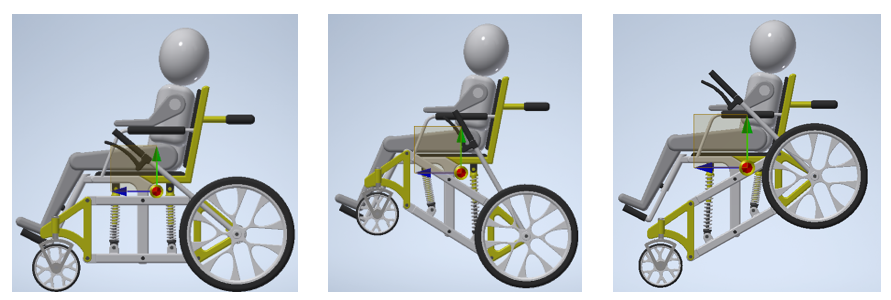Evaluasi Dinamika Titik Berat Kursi Roda pada Kemiringan Jalan 20° Berdasarkan Simulasi dan Perhitungan Analitis
DOI:
https://doi.org/10.36499/mim.v21i2.14195Keywords:
kursi roda, disabilitas fisik, stabilitas tanjakanAbstract
According to data from Indonesia’s Central Statistics Agency (BPS) and the Ministry of Social Affairs [1,2], over 5.3 million individuals with physical disabilities face mobility challenges, particularly when using wheelchairs on sloped terrain. A major issue is the instability of manual wheelchairs on steep inclines, which increases the risk of tipping and requires assistance. This study aims to evaluate the dynamics of center of gravity (COG) shifts in wheelchairs on road slopes up to 20°, using simulation and analytical calculation methods. The methodology includes literature review, wheelchair type surveys, slope condition observations, and system kinematics and force analysis. Results show that the COG remains within a safe zone during slope transitions, with reaction force distribution remaining stable between 87.63 and 93.26 kg. Pressure on the front and rear wheels remains within safety limits, avoiding deformation or loss of traction. The highest power consumption recorded was 144.56 watts during ascent, which significantly decreased on flat or descending terrain. The findings suggest that the proposed wheelchair design is adaptive, safe, and energy-efficient, making it suitable for users with disabilities navigating urban environments with varied topography.
References
Barari, A., Esmailzadeh, E., 2022. Dynamic response and control of lightweight vehicles considering moment and weight distribution. Journal of Mechanical Design 144, 61401–61410. https://doi.org/10.1115/1.4052020
Beer, F.P., Johnston, E.R., DeWolf, J.T., Mazurek, D.F., 2020. Mechanics of Materials. McGraw-Hill Education.
Chénier, F., Marquis, E., Fleury-Rousseau, M., 2023. PREPRINT-Tracking the whole-body centre of mass while seated in a wheelchair using motion capture.
Choi, H., Lee, H., Choi, J., Moon, J., Jeong, J., Joo, D., Yoo, I., 2021. Pressure distribution in tilting and reclining wheelchairs with an air cushion: A pilot study. Biomed Hum Kinet 13, 121–127. https://doi.org/10.2478/bhk-2021-0015
Gholami, M., Maroufi, M., 2023. Stability and support analysis of wheelchair systems on inclined surfaces. Biomedical Engineering and Computational Mechanics 12, 44–53.
Hartono, D., Widodo, S., 2021. Desain ergonomis kursi roda untuk medan terjal. Jurnal Rekayasa Sistem Industri 10, 112–120. https://doi.org/10.25077/jrsi.v10n2.p112-120.2021
KEMENSOS, 2022. Laporan Data Penyandang Disabilitas Nasional. Pusdatin Kemensos.
ISO 7176-5, 2008.
Kurniawan, A., 2023. Analisis gaya dan stabilitas pada kursi roda di kemiringan jalan. Jurnal Mekanika Terapan 14, 35–44.
Luo, H., Cao, X., Dong, Y., Li, Y., 2023. Simulation and experimental study on the stability and comfortability of the wheelchair human system under uneven pavement. Front Bioeng Biotechnol 11. https://doi.org/10.3389/fbioe.2023.1279675
UN, 2022. Disability and Development Report 2022. UN.
WHO, 2023. Global Report on Health Equity for Persons with Disabilities. WHO.
Kementerian PUPR, 2017. Peraturan Menteri PUPR No. 14/PRT/M/2017 tentang Persyaratan Kemudahan Bangunan Gedung. PUPR.
Serway, R.A., Jewett, J.W., 2022. Physics for Scientists and Engineers. Cengage Learning.
Setiawan, M.A., Pramudito, R.D., 2022. Smart wheelchair system for slope environments: Design and simulation. IEEE Access 10, 1–10. https://doi.org/10.1109/ACCESS.2022.3188854
BPS, 2022. Statistik Penyandang Disabilitas Indonesia 2022. BPS.
Tavakoli, M., al., et, 2022. A review of modeling and stability analysis of wheelchairs: Focus on center of gravity. International Journal of Biomechanics 59, 215–230.
Togni, R., Zemp, R., Kirch, P., Plüss, S., Vegter, R.J.K., Taylor, W.R., 2023. Steering-by-leaning facilitates intuitive movement control and improved efficiency in manual wheelchairs. J Neuroeng Rehabil 20. https://doi.org/10.1186/s12984-023-01265-x
van Dijk, M.P., Heringa, L.I., Berger, M.A.M., Hoozemans, M.J.M., Veeger, D.J.H.E.J., 2024. Towards an accurate rolling resistance: Estimating intra-cycle load distribution between front and rear wheels during wheelchair propulsion from inertial sensors. J Sports Sci 42, 611–620. https://doi.org/10.1080/02640414.2024.2353405
Zhang, Y., Wang, L., 2021. Analysis of Support Reactions in Mobility Assist Systems Using Static Equilibrium Models. J Assist Technol 15, 289–298. https://doi.org/10.1108/JAT-03-2021-0005

Downloads
Published
How to Cite
Issue
Section
License

This work is licensed under a Creative Commons Attribution 4.0 International License.
Authors who publish with this journal agree to the following terms:
The journal allow the authors to hold the copyright without restrictions and allow the authors to retain publishing rights without restrictions.
Authors retain copyright and grant the journal right of first publication with the work simultaneously licensed under a Creative Commons Attribution License that allows others to share the work with an acknowledgement of the work's authorship and initial publication in this journal.
Authors are able to enter into separate, additional contractual arrangements for the non-exclusive distribution of the journal's published version of the work (e.g., post it to an institutional repository or publish it in a book), with an acknowledgement of its initial publication in this journal.
Authors are permitted and encouraged to post their work online (e.g., in institutional repositories or on their website) prior to and during the submission process, as it can lead to productive exchanges, as well as earlier and greater citation of published work (See The Effect of Open Access).

This work is licensed under a Creative Commons Attribution 4.0 International License.








